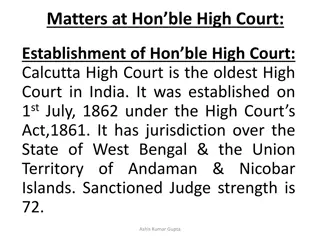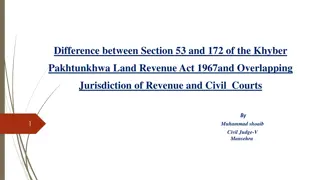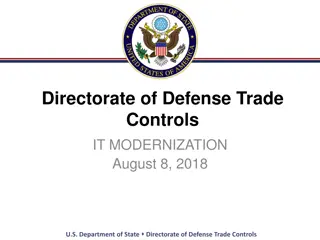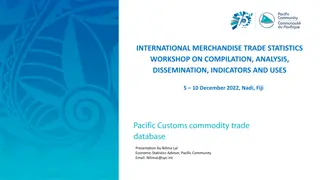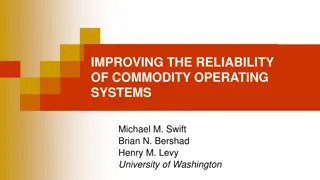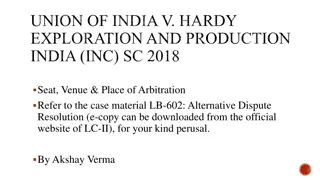DDTC: Commodity Jurisdiction and Classification Process
Explore the Directorate of Defense Trade Controls (DDTC) and its role in regulating defense exports for national security. Delve into the Commodity Jurisdiction and Classification Process, guided by the Arms Export Control Act and International Traffic in Arms Regulations. Learn about DDTC's background, governing laws, and organizational structure.
Download Presentation

Please find below an Image/Link to download the presentation.
The content on the website is provided AS IS for your information and personal use only. It may not be sold, licensed, or shared on other websites without obtaining consent from the author.If you encounter any issues during the download, it is possible that the publisher has removed the file from their server.
You are allowed to download the files provided on this website for personal or commercial use, subject to the condition that they are used lawfully. All files are the property of their respective owners.
The content on the website is provided AS IS for your information and personal use only. It may not be sold, licensed, or shared on other websites without obtaining consent from the author.
E N D
Presentation Transcript
We Value Your Feedback Please take a moment to complete our quick evaluation Tell us what we could improve AND what we did well! *Check the webinar Chat box to easy access to the link!* If you don t see the Chat box, you can find the evaluation on your browser at https://questionweb.com/59212/
COMMODITY JURISDICTIONAND CLASSIFICATION FEBRUARY 22, 2018 U.S. DEPARTMENTOF STATE OFFICEOF DEFENSE TRADE CONTROLS POLICY TRAVIS W. SCHULTZ
AGENDA Brief introduction of the Directorate of Defense Trade Controls The Commodity Jurisdiction and Classification Process 3
DDTC BACKGROUND The Directorate of Defense Trade Controls (DDTC) is a civil regulatory body within the Department of State, whose mission is to ensure commercial exports of defense articles and defense services are consistent with U.S. national security and foreign policy objectives DDTC is within the Bureau of Political-Military Affairs (PM); PM reports to the Under Secretary for Arms Control and International Security Affairs Authority comes from the Arms Export Control Act (AECA; 22 U.S.C. 2778) and implementing International Traffic in Arms Regulations (ITAR; 22 CFR Parts 120-130) Broadly speaking, the ITAR governs the export, and temporary import, of defense articles (including technical data) and defense services 4
THE LAW 2778 (a) (1) of the Arms Export Control Act (AECA) In furtherance of world peace and the security and foreign policy of the United States, the President is authorized to control the import and the export of defense articles and defense servicesand to provide foreign policy guidance to persons of the United States involved in the export and import of such articles and services. The President is authorized to designate those items which shall be considered as defense articles and defense services for the purpose of this section and to promulgate regulations for the import and export of such articles and services. The items so designated shall constitute the United States Munitions List. This authority is delegated to the Secretary of State by Executive Order 13637 5
THE IMPLEMENTING REGULATIONS International Traffic in Arms Regulations ITAR 22 Code of Federal Regulations 120-130 6
DDTC ORGANIZATION Deputy Assistant Secretary Of Defense Trade Controls Michael Miller (A) Managing Director Senior Advisors and Staff Tony Dearth (A) Office of Defense Trade Controls Compliance Office of Defense Trade Controls Licensing Office of Defense Trade Controls Policy Office of Defense Trade Controls Management (Vacant) Sarah Heidema (A) Terry Davis (A) 7
DTCP ORGANIZATION Director Sarah J. Heidema (A) Deputy Director Richard Koelling (A) Commodity Jurisdiction and Classification Division Regional Affairs and Analysis Division Regulatory and Multilateral Affairs Division Richard Koelling (A) Robert Hart (A) Nicholas Memos (A) 8
COMMODITY JURISDICTION (Almost) all items are controlled for export under the ITAR or the Export Administration Regulations (EAR), but not both ITAR controls exports of items on the U.S. Munitions List (USML) EAR (administered by the Commerce Department) controls exports of dual-use items as well as certain military items (CCL) Determining the jurisdiction and classification of a product, data, or service is the process of understanding how it is controlled under the ITAR or the EAR 9
COMMODITY JURISDICTION Two fundamental questions: 1. Is my item controlled under the ITAR? (Jurisdiction) If yes, which USML Category? (Classification) 2. If no, is it subject to the EAR? (Jurisdiction) If yes, which ECCN? (Classification) If no, is it controlled by another regulation? 10
COMMODITY JURISDICTION Why does the jurisdiction matter? If you get this wrong, every export-related decision going forward will also be wrong This determination will dictate: Controlling agency Registration requirement (ITAR) License requirements Available license exemptions/exceptions Brokering requirements (ITAR) 11
COMMODITY JURISDICTION The review of jurisdiction and classification should be an established part of company procedures Certain information will be required before you can review an item s jurisdiction and classification, and will likely come from different functional areas within your company: Engineering/Research & Development Business Development/Sales Contracts Legal Determining jurisdiction and classification should be a team effort 12
COMMODITY JURISDICTION You must have a complete understanding of the product: Product description Source of product Understanding of product capabilities Understanding of product end-uses Product specifications and drawings Real and anticipated customers for the product Any past jurisdiction or export history Comparable products, including foreign availability 13
COMMODITY JURISDICTION The jurisdiction and classification process is governed by an Order of Review ITAR 121.1(b) Online Decision Tool: http://pmddtc.state.gov/licensing/dt_OrderofReview.htm EAR 774 Supplement No. 4 Online Decision Tool: http://www.bis.doc.gov/index.php/export-control-classification- interactive-tool The Order of Review defines the steps for reviewing the ITAR and then the EAR to assess jurisdiction and classification 14
USML STRUCTURE USML Structure The USML is divided into 21 categories Each USML category includes paragraphs for articles, technical data, and defense services Review each category to determine if your item is described in an entry under that category Items may be described by multiple entries Entries are either enumerated or catch-all A catch-all control does not refer to specific types of items; rather, it controls unspecified specially designed items (Note to ITAR 120.41(b)) 15
USML STRUCTURE Catch-all example USML Category VIII(h)(1) Parts, components, accessories, and attachments specially designed for the B- 1B Enumerated examples USML Category VIII(a)(1) Bombers USML Category VIII(a)(5) Unmanned Aerial Vehicles (UAVs) specially designed to incorporate a defense article Specially designed catch-all some enumerated entries use specially designed as a control criterion 16
ORDEROF REVIEW If described by only one USML entry that does not use the term specially designed, then your analysis is complete and the item is ITAR- controlled under that USML category ITAR EAR EAR ITAR EAR EAR USML CCL CCL USML CCL EAR99 Specially Designed* 600/500 Series Specially Designed* 17
ORDEROF REVIEW If described in multiple paragraphs, any paragraph that is designated as Significant Military Equipment (SME) takes precedence over a non-SME paragraph If described in an enumerated entry that uses specially designed control text, a specially designed analysis is required 18
ORDEROF REVIEW If not described by an enumerated entry on the USML, your next step is to see if the item is described in a catch-all paragraph Catch-all paragraphs all require a specially designed analysis ITAR EAR EAR ITAR EAR EAR USML CCL CCL USML CCL EAR99 Specially Designed* 600/500 Series Specially Designed* 19
ORDEROF REVIEW Is the item described by a paragraph that uses the phrase specially designed ? Example: USML Category VII(g)(3) - Composite armor parts and components specially designed for USML Category VII vehicles; If yes, perform the ITAR 120.41 specially designed analysis If the item is not described in any USML paragraph, then it is not ITAR-controlled and the review moves to the EAR 20
SPECIALLY DESIGNED ITAR 120.41 Specially designed controls are structured as a catch and release There are two catches A commodity or software may be specially designed if: 120.41(a)(1) As a result of development, it has properties peculiarly responsible for achieving or exceeding the controlled performance levels, characteristics, or functions described in the relevant USML paragraph 21
SPECIALLY DESIGNED ITAR 120.41 As a result of development: Even if a commodity or software is capable of use with a defense article, it is not captured by paragraph (a)(1) unless someone did something during the commodity s development for it to achieve or exceed the performance levels, characteristics, or functions described in a referenced USML paragraph 22
SPECIALLY DESIGNED ITAR 120.41 A commodity may also be specially designed if it: 120.41(a)(2) - is a part, component, accessory, attachment, or software for use in or with a defense article While this is a very broad catch, there are five potential releases from a specially designed control provided by 120.41(b)(1) through (5) 23
SPECIALLY DESIGNED ITAR 120.41 A part, component, accessory, attachment, or software is not specially designed if it meets one of the release criteria: 120.41(b)(1) - is subject to the EAR pursuant to a CJ determination 120.41(b)(2) - is, regardless of form or fit, a fastener, washer, spacer, insulator, grommet, bushing, spring, wire, or solder 24
SPECIALLY DESIGNED ITAR 120.41 (CONT.) Subsequent to promulgation of the specially designed definition, we defined some of the terms used in paragraph (b)(2) For example, wire: single conductor and stranded conductor, with or without insulation 25
SPECIALLY DESIGNED ITAR 120.41 (CONT.) This, on the other hand, is not wire. So, do not stretch the meaning of the terms in paragraph (b)(2) 26
SPECIALLY DESIGNED ITAR 120.41 Bear in mind that the paragraph (b) releases do not apply to end-items, systems, equipment, firmware, or technical data directly related to defense articles See ITAR 120.45 for definitions of these terms 27
SPECIALLY DESIGNED ITAR 120.41 A part, component, accessory, attachment, or software is also not specially designed if it: 120.41(b)(3) - has the same function, performance capabilities, and the same or equivalent form and fit as a commodity or software used in or with a commodity that: is or was in production (i.e., not in development); and is not enumerated on the USML 28
SPECIALLY DESIGNED ITAR 120.41 Defined terms in the definition: Function - action or actions a commodity is designed to perform Performance capability - the measure of a commodity's effectiveness to perform a designated function in a given environment Equivalent - form has been modified solely for fit purposes Form configuration (including the geometrically measured configuration), material, and material properties that uniquely characterize a commodity Fit the ability of a commodity to physically interface or connect with or become an integral part of another commodity 29
SPECIALLY DESIGNED ITAR 120.41 Defined terms in the definition: Production means all production stages, such as product engineering, manufacture, integration, assembly (mounting), inspection, testing, and quality assurance Development is related to all stages prior to serial production, such as: design, design research, design analyses, design concepts, assembly and testing of prototypes, pilot production schemes, design data, process of transforming design data into a product, configuration design, integration design, and layouts 30
SPECIALLY DESIGNED ITAR 120.41 For software: Form means the design, logic flow, and algorithms Fit means its ability to interface or connect with a defense article Function means the action or actions the software performs directly related to a defense article or as a standalone application Performance capability is the measure of the software's effectiveness to perform a designated function 31
SPECIALLY DESIGNED ITAR 120.41 A part, component, accessory, attachment, or software is also not specially designed if it: 120.41(b)(4) - was or is being developed with knowledge that it is or would be for use in or with both defense articles and commodities not on the USML 120.41(b)(5) - was or is being developed as a general purpose commodity or software, with no knowledge for use in or with a particular commodity or type of commodity (e.g., an aircraft or machine tool) 32
SPECIALLY DESIGNED ITAR 120.41 Note to 120.41(b)(4) and (b)(5) Must have documents contemporaneous with development that establish that the commodity was or is being developed as a general purpose commodity, or for use in or with both defense articles and commodities not on the USML. Such documentation includes concept design information, marketing plans, declarations in patent applications, or contracts 33
SPECIALLY DESIGNED ITAR 120.41 Specially designed has been discussed at length by State and Commerce: State s rule: 78 Federal Register 22740 Commerce s rule: 78 Federal Register 22660 TIP: Try out the specially designed tool at: http://pmddtc.state.gov/licensing/dt_SpeciallyDesigned.htm 34
ITAR ORDEROF REVIEW EXAMPLE Washer for a tail boom folding system This is a part for an aircraft system, so review USML Category VIII(h): (h) Parts, components, accessories, attachments, associated equipment and systems, as follows: (3) Tail boom folding systems, stabilator folding systems or automatic rotor blade folding systems, and specially designed parts and components therefor; 35
ITAR ORDEROF REVIEW EXAMPLE Specially designed is a control criterion for tail boom parts, so proceed to 120.41 and continue your analysis: 120.41(a)(2) applies: it is a part used in a defense article Washer is caught But, we also see that 120.41(b)(2) applies: for purposes of the ITAR, washers are not specially designed Washer is released 36
ITAR ORDEROF REVIEW EXAMPLE Static-line anchor cable for a CH-47 Chinook Review USML Category VIII (Military Aircraft) USML Category VIII(h) Parts, components, accessories, attachments, associated equipment and systems Not described in any paragraph (h) subparagraph Proceed to the EAR (starting at 600 series control) 37
WHEN DOES REQUESTINGA CJ DETERMINATION MAKE SENSE? The ITAR does not require the submission of CJ determination requests. Self-determination is warranted when there is no doubt as to both the commodity s jurisdiction and classification When doubt exists, submit a CJ request to DDTC using form DS-4076 via the automated Defense Export Control and Compliance System (DECCS) 38
COMMODITY JURISDICTION ITAR 120.4 Commodity Jurisdiction: (d)(2) A designation that an article or service meets the criteria of a defense article or defense service, or provides equivalent capabilities of a defense article on the USML, is made on a case-by-case basis by the Department of State taking into account: (i) the form and fit of the article; and (ii) the function and performance capability of the article. (d)(3) A designation that an article or service has a critical military or intelligence advantage such that it warrants control is made, on a case- by-case basis, by the Department of State taking into account: (i) The function and performance capability of the article; and (ii) The nature of controls imposed by other nations on such items. 39
SUBMITTINGA CJ DETERMINATION REQUEST Submit a CJ request online via DECCS: Link: https://cj.pmddtc.state.gov/ DECCS Webinar: Link: https://www.pmddtc.state.gov/outreach/itmod.html 40
SUBMITTINGA CJ DETERMINATION REQUEST Applicant should be the original equipment manufacturer (OEM) While there are exceptions, if you re not the OEM you must have authorization to submit the CJ An example authorization is on the CJ home page Review the FAQs and the online instructions on the DDTC website under the CJ link: http://www.pmddtc.state.gov/commodity_jurisdiction/index.html 41
CJ DETERMINATION PROCESS After applicant submits CJ through DECCS CJ request is assigned a case number: CJ XXXX-18; 18 indicates the year A State Department analyst conducts a preliminary analysis and staffs to the interagency for review Interagency review participants: Department of Commerce Department of Defense Department of Homeland Security As necessary: NASA Department of Energy Other U.S. government agencies 42
CJ DETERMINATION PROCESS Unanimous jurisdiction recommendations from the reviewing agencies result in a final determination letter State is responsible for resolving differing recommendations among the reviewing agencies and has final authority on the determination Disagreement on the jurisdiction can significantly slow down conclusion of the CJ request 43
CJ DETERMINATION PROCESS When review is completed, State will issue a jurisdictional determination (ITAR-controlled, EAR- controlled, or neither) ITAR results will include classification EAR results may include classification A CJ determination issued by State is the only legal document issued by the government regarding the jurisdiction of a commodity CJ determination letter is sent to the e-mail address provided in DS-4076 44
COMMODITY JURISDICTION WEB PAGE You will find: Link to DECCs Tips for completing a successful CJ application CJ Status via ELISA (http://elisa.dtsa.mil/Elisa_Results.aspx) For informational purposes, the DS-4076 data collection FAQs Final determinations database Contact information Visit: http://pmddtc.state.gov/commodity_jurisdiction/index.html For questions regarding the CJ application, contact the DDTC Response Team: (202) 663-1282 DDTCResponseTeam@state.gov 45
COMMODITY JURISDICTION DETERMINATIONS 46
We Value Your Feedback Please take a moment to complete our quick evaluation Tell us what we could improve AND what we did well! *Check the webinar Chat box to easy access to the link!* If you don t see the Chat box, you can find the evaluation on your browser at https://questionweb.com/59212/





